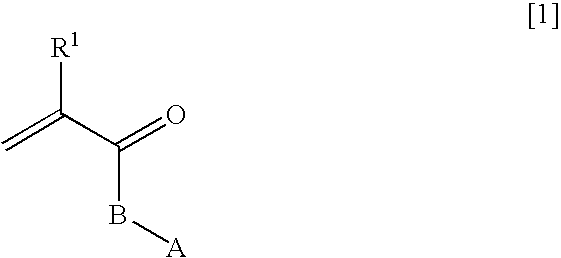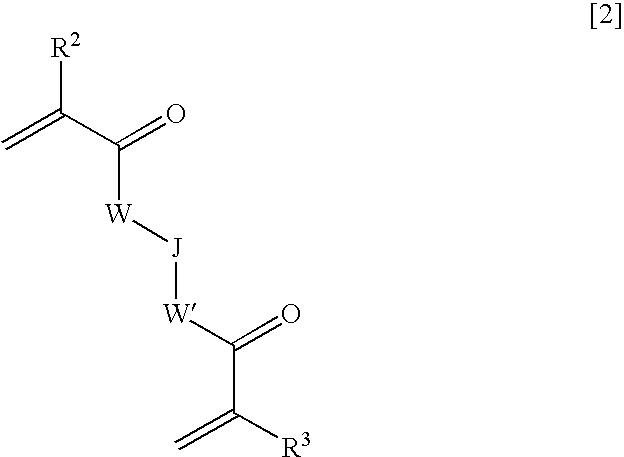Ophthalmic and otorhinolaryngological device materials
- Summary
- Abstract
- Description
- Claims
- Application Information
AI Technical Summary
Benefits of technology
Problems solved by technology
Method used
Image
Examples
example 1
[0102]All monomers, cross-linkers and initiators were purchased from commercial sources. Macromer [3] (“polyPEG-MA”) was synthesized from poly(ethylene glycol) 550 monomethyl ether monomethacrylate (“PEG-MA 550”). Two macromer [3] molecular weights were used: “polyPEG-MA 4.1 k” (GPC Mn 4,112; Mw / Mn of 1.80; e=7 (calculated as 4112 / 550)) and “polyPEG-MA 10.3 k” (GPC Mn 10,300; Mw / Mn of 1.44; e=19). 2-phenylethyl methacrylate (PEMA) and benzyl methacrylate (BzMA) were each passed through basic alumina and degassed with N2 prior to use. 2-Phenylethyl acrylate (“PEA”), benzyl acrylate (“BzA”), and 1,4-butanediol diacrylate (“BDDA”) were purified by column chromatography prior to use. 2,2-Azobisisobutyronitrile (“AIBN”) was recrystallized from methanol prior to use. Di-(4-t-butylcyclohexyl)peroxydicarbonate (“Perkadox® 16S”), 2-(2′-Hydroxy-3′-t-butyl-5′-(3″-(2′″-hydroxy-3′″-methacryloyloxypropoxy)propoxy)phenyl)-5-methoxy-2H-benzotriazole (“UV13”), and ortho-methallyl Tinuvin® P (“oMTP”)...
example 2
[0104]The copolymers shown in Table 3, which contained varying sizes of PEG-containing additive (PEG-MA 550, PolyPEG-MA 4.1 k, and PolyPEG-MA 10.3 k), were prepared in the manner described in Example 1. Tensile properties, EWC, glistening resistance, and refractive index were determined according to the methods described above. The results are listed in Table 4.
TABLE 3Comparative Examples Formulation Component DetailBzABDDAPEG-MAPolyPEG-MAPolyPEG-MAID(wt %)(wt %)550 (wt %)4.1k (wt %)10.3k (wt %)2693.471.515.02——2793.471.51—5.02—2893.491.51——5.00
TABLE 4Comparative Formulation Tensile and Thermal Properties,% EWC and Glistening Test Results100%TensileStrain atYoung'sSecantStrengthBreakModulusModulusEWCRIID(MPa)(MPa)(MPa)(MPa)(%)Glistenings(22° C., dry)266.8719112.791.640.59Many1.5598277.4918916.251.851.50None1.5604288.9219925.322.222.35None1.5595
example 3
[0105]The copolymers shown in Table 5, which contained varying molecular weights of the polyPEG-MA additive: “polyPEG-MA 3570” (GPC Mn 3570; Mw / Mn of 1.42; e=6), “polyPEG-MA 4012” (GPC Mn 4012; Mw / Mn 1.54; e=7), “polyPEG-MA 4141” (GPC Mn 4141; Mw / Mn 1.50; e=8), and polyPEG-MA 3708 (GPC Mn 3708; Mw / Mn 1.49; e=7) were prepared in the manner described in Example 1. Tensile properties, EWC, glistening resistance, and refractive index were determined according to the methods described above. The results are listed in Table 6.
TABLE 5Formulation Component DetailPEG-MAPolyPEG-PolyPEG-PolyPEG-PolyPEG-BzABzMABDDA550MA 3570MA 4012MA 4141MA 3708ID(wt %)(wt %)(wt %)(wt %)(wt %)(wt %)(wt %)(wt %)2985.479.991.523.02————3083.469.991.515.03————3178.4910.011.5010.00————3273.5010.001.5115.00————3368.5010.001.5020.00————3485.4610.001.53—3.00———3583.4710.021.50—5.01———3685.389.991.61——3.02——3785.4710.001.50———3.03—3885.4010.011.52————3.07
TABLE 6Tensile and Thermal Properties, % EWC and Glistening Test R...
PUM
| Property | Measurement | Unit |
|---|---|---|
| Fraction | aaaaa | aaaaa |
| Fraction | aaaaa | aaaaa |
| Fraction | aaaaa | aaaaa |
Abstract
Description
Claims
Application Information
 Login to View More
Login to View More - R&D
- Intellectual Property
- Life Sciences
- Materials
- Tech Scout
- Unparalleled Data Quality
- Higher Quality Content
- 60% Fewer Hallucinations
Browse by: Latest US Patents, China's latest patents, Technical Efficacy Thesaurus, Application Domain, Technology Topic, Popular Technical Reports.
© 2025 PatSnap. All rights reserved.Legal|Privacy policy|Modern Slavery Act Transparency Statement|Sitemap|About US| Contact US: help@patsnap.com



